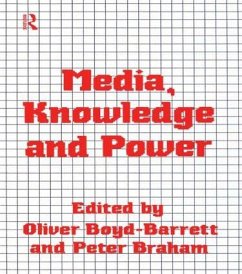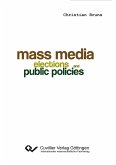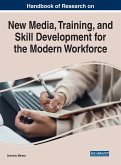- Broschiertes Buch
- Merkliste
- Auf die Merkliste
- Bewerten Bewerten
- Teilen
- Produkt teilen
- Produkterinnerung
- Produkterinnerung
First Published in 1986. Routledge is an imprint of Taylor & Francis, an informa company.
Andere Kunden interessierten sich auch für
![Media, Technology and Everyday Life in Europe Media, Technology and Everyday Life in Europe]() Media, Technology and Everyday Life in Europe66,99 €
Media, Technology and Everyday Life in Europe66,99 €![Museum, Media, Message Museum, Media, Message]() Museum, Media, Message248,99 €
Museum, Media, Message248,99 €![Museum, Media, Message Museum, Media, Message]() Museum, Media, Message84,99 €
Museum, Media, Message84,99 €![Mass Media, Elections, and Public Policies Mass Media, Elections, and Public Policies]() Christian BrunsMass Media, Elections, and Public Policies21,00 €
Christian BrunsMass Media, Elections, and Public Policies21,00 €![How to Start a Clothing Company - Deluxe Edition Learn Branding, Business, Outsourcing, Graphic Design, Fabric, Fashion Line Apparel, Shopify, Fashion, Social Media, and Instagram Marketing How to Start a Clothing Company - Deluxe Edition Learn Branding, Business, Outsourcing, Graphic Design, Fabric, Fashion Line Apparel, Shopify, Fashion, Social Media, and Instagram Marketing]() Cameron BrewerHow to Start a Clothing Company - Deluxe Edition Learn Branding, Business, Outsourcing, Graphic Design, Fabric, Fashion Line Apparel, Shopify, Fashion, Social Media, and Instagram Marketing19,99 €
Cameron BrewerHow to Start a Clothing Company - Deluxe Edition Learn Branding, Business, Outsourcing, Graphic Design, Fabric, Fashion Line Apparel, Shopify, Fashion, Social Media, and Instagram Marketing19,99 €![Handbook of Research on New Media, Training, and Skill Development for the Modern Workforce Handbook of Research on New Media, Training, and Skill Development for the Modern Workforce]() Handbook of Research on New Media, Training, and Skill Development for the Modern Workforce321,99 €
Handbook of Research on New Media, Training, and Skill Development for the Modern Workforce321,99 €![Media, Mindfulness, and Mental Health Media, Mindfulness, and Mental Health]() Quentin QuasimodoMedia, Mindfulness, and Mental Health24,99 €
Quentin QuasimodoMedia, Mindfulness, and Mental Health24,99 €-
-
-
First Published in 1986. Routledge is an imprint of Taylor & Francis, an informa company.
Hinweis: Dieser Artikel kann nur an eine deutsche Lieferadresse ausgeliefert werden.
Hinweis: Dieser Artikel kann nur an eine deutsche Lieferadresse ausgeliefert werden.
Produktdetails
- Produktdetails
- Verlag: Routledge
- Seitenzahl: 496
- Erscheinungstermin: 27. November 1986
- Englisch
- Abmessung: 216mm x 140mm x 27mm
- Gewicht: 618g
- ISBN-13: 9780415058742
- ISBN-10: 0415058740
- Artikelnr.: 31385450
- Herstellerkennzeichnung
- Libri GmbH
- Europaallee 1
- 36244 Bad Hersfeld
- gpsr@libri.de
- Verlag: Routledge
- Seitenzahl: 496
- Erscheinungstermin: 27. November 1986
- Englisch
- Abmessung: 216mm x 140mm x 27mm
- Gewicht: 618g
- ISBN-13: 9780415058742
- ISBN-10: 0415058740
- Artikelnr.: 31385450
- Herstellerkennzeichnung
- Libri GmbH
- Europaallee 1
- 36244 Bad Hersfeld
- gpsr@libri.de
Oliver Boyd-Barrett, Peter Braham
1: Communications Across the World
1: Introduction
1.1: Many Voices, One World
1.2: Human Communication and its History
2: Communications and Social Power
2: Introduction
2.1: The Study of the Media: Theoretical Approaches
2.2: Processes of Media Effects
2.3: Down to Cases
2.4: The Glasgow Dustcart Drivers' Strike
2.5: Semiological Analysis
2.6: Canada: Nation-building Threatened by the US-Dominated Media
2.7: The Infrastructure of the 'Information Society'
3: Media 'Forms' and Their Effects
3: Introduction
3.1: A Schema for the Study of Graphic Language
3.2: Learning through Experience and Learning through Media
3.3: The Use of Visual Media in the Service of Enriching Mental Thought Processes
3.4: The Forms of Television: Effects on Children's Attention Comprehension and social Behavior
4: Media Education
4: Introduction
4.1: Socialization and Television
4.2: Improving the Educational Effectiveness of Television Case-Studies and Documentaries
4.3: Computers and Writing
4.4: Computer Models in the Teaching a of Biology
4.5: Software through Prestel: the Case of Inverkeithing High School
4.6: Television, Film and Media Education
5: Information, Dissemination and Innovation
5: Introduction
5.1: Trends and Issues in Information Science - a General Survey
5.2: Scientific Communication: Five Sociological Themes
5.3: The Supply and Demand for Information about Education
5.4: Artistry and Teaching: The Teacher as Focus of Research and Development
5.5: The Rhetoric of School-Centred Innovation
1: Introduction
1.1: Many Voices, One World
1.2: Human Communication and its History
2: Communications and Social Power
2: Introduction
2.1: The Study of the Media: Theoretical Approaches
2.2: Processes of Media Effects
2.3: Down to Cases
2.4: The Glasgow Dustcart Drivers' Strike
2.5: Semiological Analysis
2.6: Canada: Nation-building Threatened by the US-Dominated Media
2.7: The Infrastructure of the 'Information Society'
3: Media 'Forms' and Their Effects
3: Introduction
3.1: A Schema for the Study of Graphic Language
3.2: Learning through Experience and Learning through Media
3.3: The Use of Visual Media in the Service of Enriching Mental Thought Processes
3.4: The Forms of Television: Effects on Children's Attention Comprehension and social Behavior
4: Media Education
4: Introduction
4.1: Socialization and Television
4.2: Improving the Educational Effectiveness of Television Case-Studies and Documentaries
4.3: Computers and Writing
4.4: Computer Models in the Teaching a of Biology
4.5: Software through Prestel: the Case of Inverkeithing High School
4.6: Television, Film and Media Education
5: Information, Dissemination and Innovation
5: Introduction
5.1: Trends and Issues in Information Science - a General Survey
5.2: Scientific Communication: Five Sociological Themes
5.3: The Supply and Demand for Information about Education
5.4: Artistry and Teaching: The Teacher as Focus of Research and Development
5.5: The Rhetoric of School-Centred Innovation
1: Communications Across the World
1: Introduction
1.1: Many Voices, One World
1.2: Human Communication and its History
2: Communications and Social Power
2: Introduction
2.1: The Study of the Media: Theoretical Approaches
2.2: Processes of Media Effects
2.3: Down to Cases
2.4: The Glasgow Dustcart Drivers' Strike
2.5: Semiological Analysis
2.6: Canada: Nation-building Threatened by the US-Dominated Media
2.7: The Infrastructure of the 'Information Society'
3: Media 'Forms' and Their Effects
3: Introduction
3.1: A Schema for the Study of Graphic Language
3.2: Learning through Experience and Learning through Media
3.3: The Use of Visual Media in the Service of Enriching Mental Thought Processes
3.4: The Forms of Television: Effects on Children's Attention Comprehension and social Behavior
4: Media Education
4: Introduction
4.1: Socialization and Television
4.2: Improving the Educational Effectiveness of Television Case-Studies and Documentaries
4.3: Computers and Writing
4.4: Computer Models in the Teaching a of Biology
4.5: Software through Prestel: the Case of Inverkeithing High School
4.6: Television, Film and Media Education
5: Information, Dissemination and Innovation
5: Introduction
5.1: Trends and Issues in Information Science - a General Survey
5.2: Scientific Communication: Five Sociological Themes
5.3: The Supply and Demand for Information about Education
5.4: Artistry and Teaching: The Teacher as Focus of Research and Development
5.5: The Rhetoric of School-Centred Innovation
1: Introduction
1.1: Many Voices, One World
1.2: Human Communication and its History
2: Communications and Social Power
2: Introduction
2.1: The Study of the Media: Theoretical Approaches
2.2: Processes of Media Effects
2.3: Down to Cases
2.4: The Glasgow Dustcart Drivers' Strike
2.5: Semiological Analysis
2.6: Canada: Nation-building Threatened by the US-Dominated Media
2.7: The Infrastructure of the 'Information Society'
3: Media 'Forms' and Their Effects
3: Introduction
3.1: A Schema for the Study of Graphic Language
3.2: Learning through Experience and Learning through Media
3.3: The Use of Visual Media in the Service of Enriching Mental Thought Processes
3.4: The Forms of Television: Effects on Children's Attention Comprehension and social Behavior
4: Media Education
4: Introduction
4.1: Socialization and Television
4.2: Improving the Educational Effectiveness of Television Case-Studies and Documentaries
4.3: Computers and Writing
4.4: Computer Models in the Teaching a of Biology
4.5: Software through Prestel: the Case of Inverkeithing High School
4.6: Television, Film and Media Education
5: Information, Dissemination and Innovation
5: Introduction
5.1: Trends and Issues in Information Science - a General Survey
5.2: Scientific Communication: Five Sociological Themes
5.3: The Supply and Demand for Information about Education
5.4: Artistry and Teaching: The Teacher as Focus of Research and Development
5.5: The Rhetoric of School-Centred Innovation








